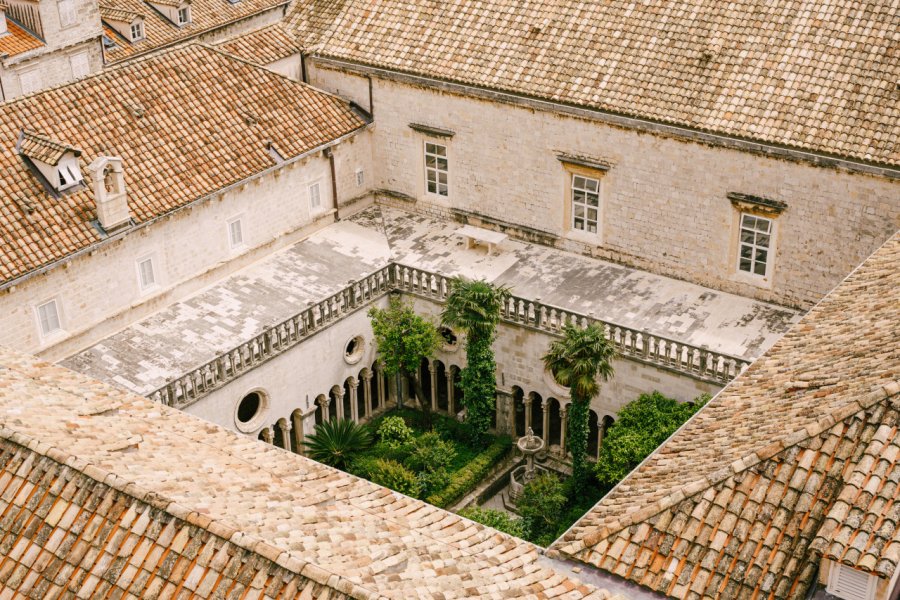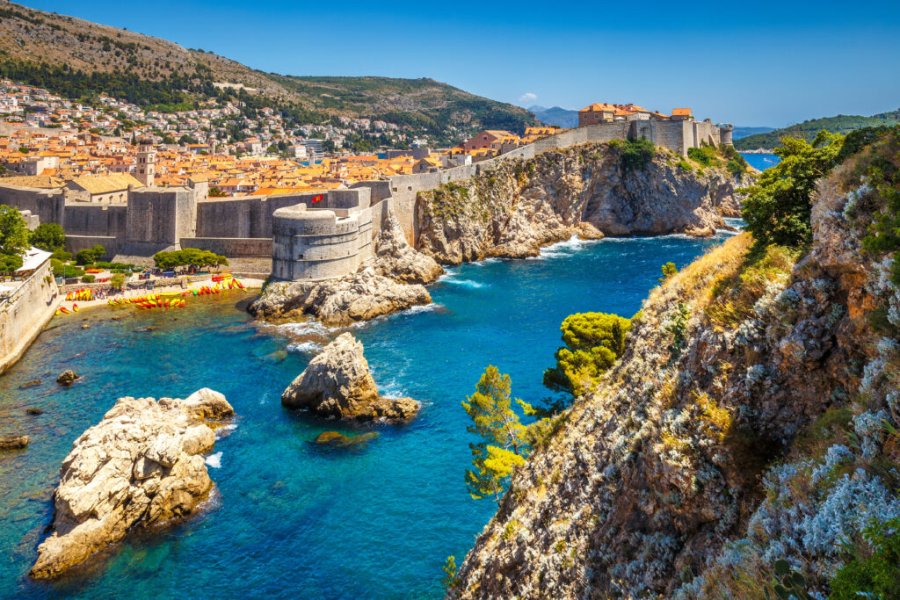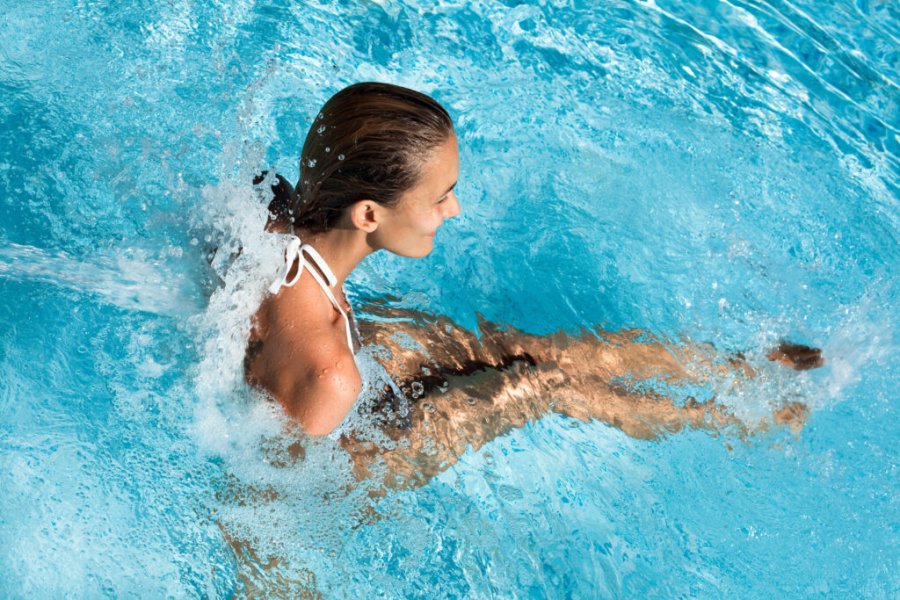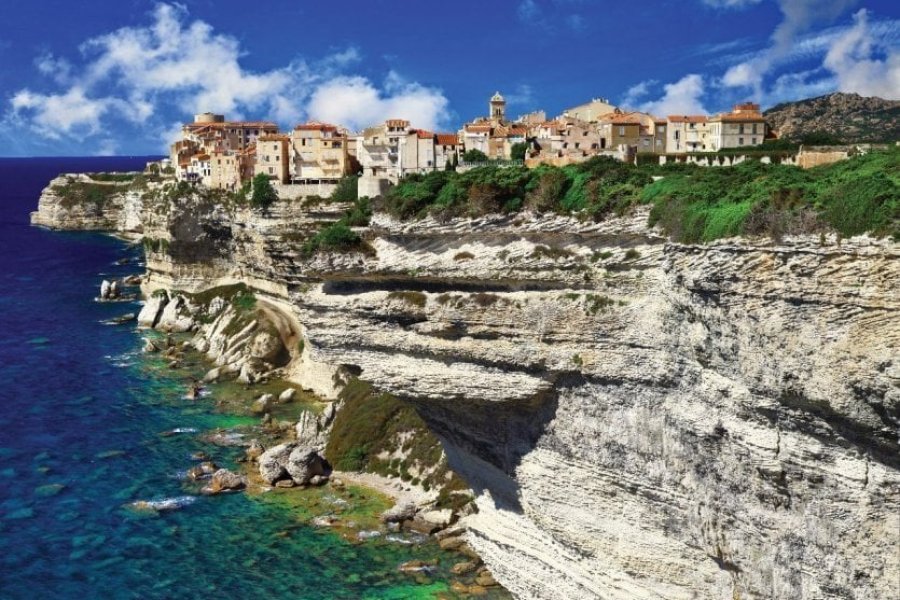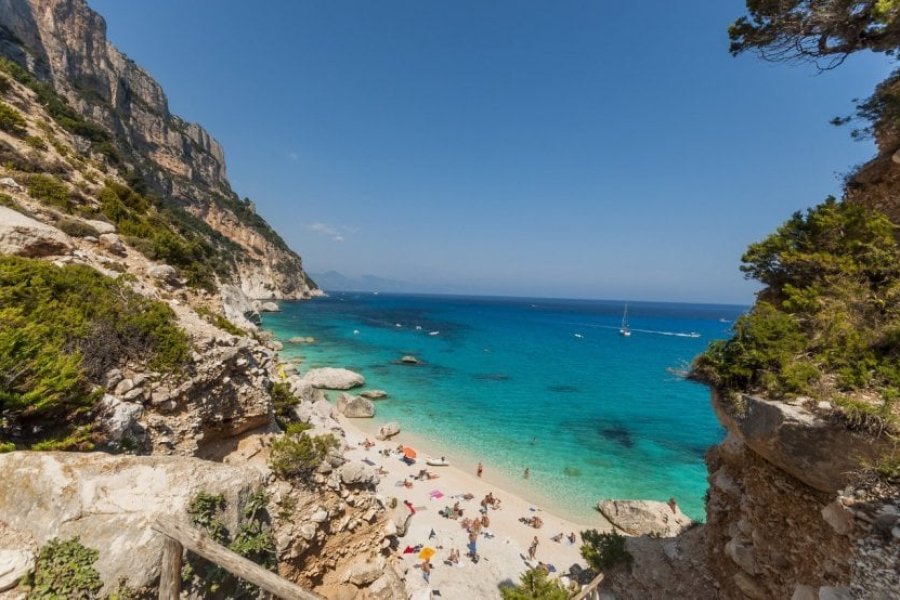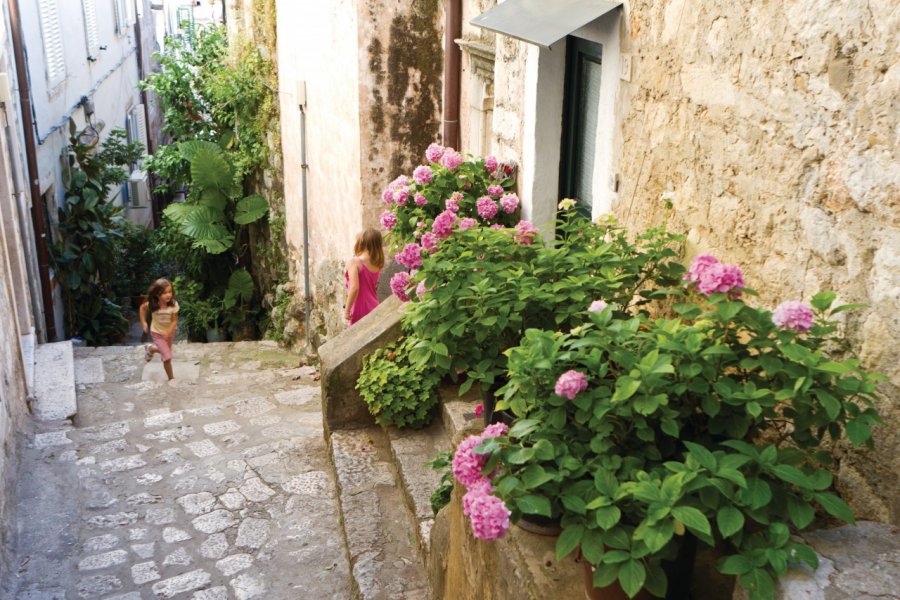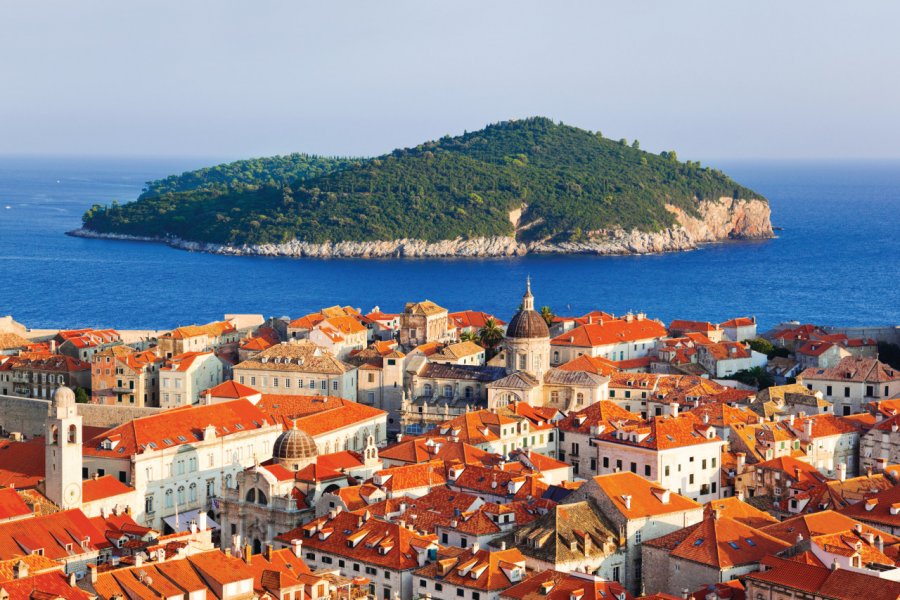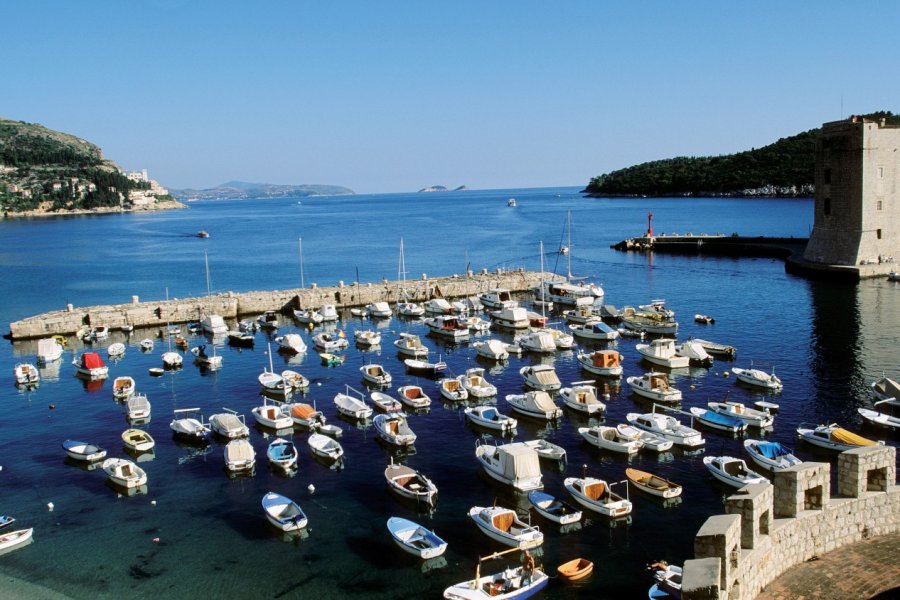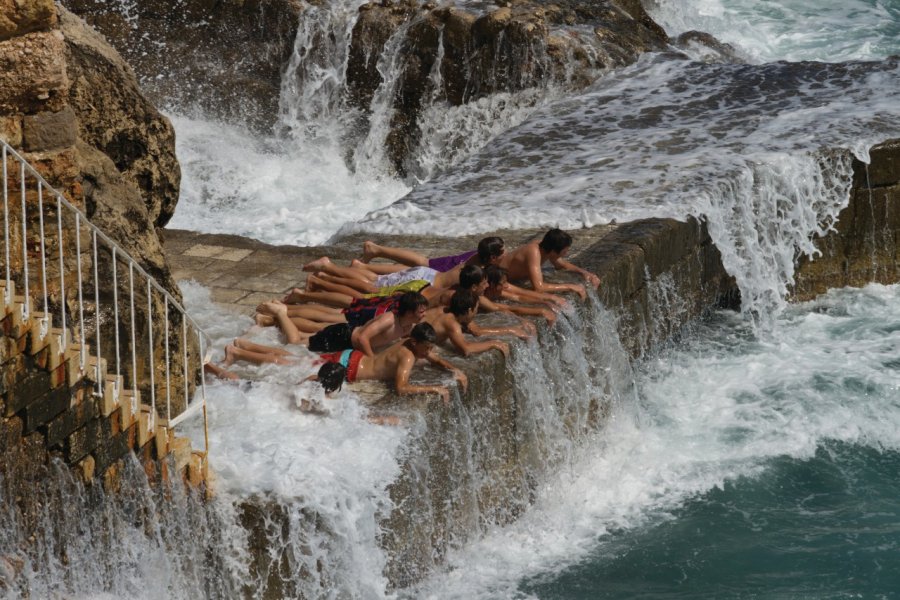Travel guide Dubrovnik
In southern Croatia, on the Adriatic Sea and at the foot of the Srd mountain, the Dubrovnik peninsula (formerly Ragusa) shelters the ancient city sheltered by gigantic 16th century stone ramparts, a world heritage site rich in preserved historical monuments, from the Baroque Saint-Blaise church to the Renaissance palace Sponza, including the Rector's Palace, in Gothic style, which houses the History Museum. Dubrovnik's commercial heart beats along the pedestrian street Stradum, which offers shops, terraces and restaurants. Since the end of the Second World War, the site has become a renowned seaside destination with an alternation of coves and beaches, including the mythical Banje beach, to enjoy the water sports. On the program: swimming, sailing, windsurfing, jet-skiing, diving... Due to tourism, the site has a large number of restaurants and hotels in different comfort ranges. To get higher, walk on the ramparts which offer you a view of the sea and the mountain and allow you to spot the city's monuments. Dubrovnik's must-see attractions include the Maritime Museum, the Aquarium of the Biological Institute, the Ethnographic Museum, the Cathedral and the Franciscan and Dominican monasteries. You can also schedule a visit to the Trsteno arboretum, 20 km from Dubrovnik. Players will enjoy the sumptuous Golden Sun Casino and series fans will be sure to think of Game of Thrones, which has Dubrovnik as its main setting.
What to see, what to do Dubrovnik?
-
Book an activity
-
Customized travel
- Addresses to visit Dubrovnik
When to go Dubrovnik ?
The high tourist season in Dubrovnik is definitely the summer, in July and August. The sun is shining, the sea is warm and the famous Dubrovnik Summer Festival (theater, music festival and folklore), held from July 10 to August 25, enlivens the city. The nightlife is lively. The Dubrovnik Carnival in February is also worth a visit. At this time, we also celebrate St. Blaise (February 3), the patron saint of the city of Dubrovnik. However, a very pleasant climate from the beginning of April to the end of September and some nice days in October allow for stays more than half the year. November is the least suitable month for a stay. It is also during this period that everything is closed. The low tourist season runs from November to the end of March. With temperatures between 7 and 15°C from December to March, winter remains pleasant. Please note that the price of accommodation doubles in July and August compared to the rest of the year.
Weather at the moment
Suggested addresses Dubrovnik
Travel Dubrovnik
-
Find a hotel
-
Car Rental
-
International e-SIM package
-
Find a local agency
Find unique Stay Offers with our Partners
How to go Dubrovnik
How to go alone
You can easily reach Dubrovnik by car, plane or bus from major European cities, by ferry from Italy, but not by train. The city is not served by the railway network. If you plan to stay in the summer, it is best to book your accommodation in advance. If your goal is not to have your feet in the water, you can find charming accommodations in the old town.
How to go on a tour
Like all tourist destinations, Dubrovnik is offered by many travel professionals. The turnkey weekend formula for the shoulder seasons and the all-inclusive beach stay formula for the summer. You can also choose from the catalog of specialized sports stays for sailing, diving, etc...
How to get around
The best way to get around and enjoy the many attractions of Dubrovnik is on foot. You can also take advantage of the modern, air-conditioned Libertas bus network. You can buy bus tickets from the driver, at newsstands, at the bus station, at the hotel reception and at tourist agencies. The ticket is valid for one hour from the time of check-in for an unlimited number of trips in the city.
Featured articles Dubrovnik
Discover Dubrovnik
Croatia's most beautiful historic city! Sheltered by mighty forts and thick ramparts protecting palaces, churches and monasteries, Dubrovnik was an independent republic for centuries. Then the former Ragusa, now King's Landing, became the perfect backdrop for the Game of Thrones series. Despite its sometimes problematic tourist overcrowding, the historic city has retained its prestige. In summer, its theater and music festival remains one of the country's most important cultural events. The "Pearl of the Adriatic" is also a vacation destination, with its beaches, sports and water sports in turquoise waters. The region promises a wealth of discoveries, with other beautiful cities to visit (Cavtat, Korčula) and superb archipelagos. You can follow the rivieras, hike in the hinterland, build agro-tourism trails (Konavle plain or Pelješac, where the best Croatian wines are produced).
Pictures and images Dubrovnik
The 12 keywords Dubrovnik
1. #Bura
The bora, or bura in Croatian, is a violent, cold wind that arrives in winter from the Velebit mountains and dies over the Adriatic Sea. This wind sometimes gives rise to impressive gusts and cools the temperature considerably. On the plus side, it brings fine weather, unlike the south wind jugo.
2. #Buža
Literally, buža means "hole". This is the name of the most popular and original bar in Dubrovnik's old town. In fact, there are two buža, set into the rocks south of the city walls. Both overlook the sea and offer an absolutely unique view! You can even take a dip in the Adriatic.
3. #Dingač

It's the famous red wine produced on the land of the locality of Dingač, in Pelješac, and one of the rising stars of Croatian viticulture. This appellation d'origine contrôlée, made from the local plavac mali grape variety, a cousin of the American zinfandel, produces a characterful red wine with subtle aromas and a beautiful ruby color.
4. #Island
Nearly a hundred islands and islets dot the Dubrovnik region. Some are very different from others: small or large, flat or mountainous, inhabited or deserted, these islands are home to a plethora of coves and beaches. The island of Korčula is one of the largest, followed by Mljet, part of which is a national park.
5. #Kava

Coffee is drunk at any time of the day, whether at the end of a meal or during the day. As a result, the terraces are always full. The coffee served in bars and restaurants is Italian-style espresso, cappuccino and macchiato. At home, it's often served Turkish-style. The 10 a.m. break is the marenda.
6. #Klapa
This polyphonic song is often heard in the Dubrovnik region and in Dalmatia. It is sung by traditionally male choirs. You may hear them rehearsing as you pass a church or concert hall, or even on the street during festivals. The town of Cavtat organizes an annual klapa competition in summer.
7. #Konoba

Konoba means "tavern" in Croatian, but in reality it refers to any of the typical restaurants along the Dalmatian coast. The konoba is traditionally a rustic, small-capacity establishment with a grill area, serving mainly fish dishes. Sometimes, it also serves as a bar.
8. #Lighthouses
With the inevitable automation of lighthouses, janitors are becoming increasingly rare. Except that these vacant dwellings have been converted into lodgings for holidaymakers thirsty for solitude and sea air. In the Dubrovnik region, you can stay at the lighthouses of Pločica (between Korčula and Hvar) and Palagruža, south of Lastovo.
9. #Ragusa
This was the former name of Dubrovnik and its proud independent republic. The term evokes the golden age of the pearl of the Adriatic, which stretched from Neum through Konavle to Prevalka (on the border with Montenegro today), and included the Elaphite islands, Lastovo and Mljet, as well as the Pelješac peninsula.
10. #Rakija
A common spirit throughout the Balkan Peninsula, rakija is also served in the Dubrovnik region. It is flavored with herbs(travarica), walnuts(orahovica) or prunes (šljivovica). Milder: honey rakija(medica). Rarer (but very good): sage(kadulja) or quince(dunja).
11. #SaintBlaise

Dubrovnik's patron saint is Saint Blaise (Sveti Vlaho), who has been the city's protector for over a thousand years. A 4th-century Christian martyr and bishop in Cappadocia, he appeared in a dream to a Dubrovnik shepherd in the 10th century, announcing an imminent attack on the city of Venice. This gave the Ragusans time to prepare a counter-attack.
12. #Stradun
It's THE main street in the old town! Also known as placa (official name), locals prefer the Italian-sounding stradun. Paved with stones from the island of Brač, it divides the old town into two parts and has no numbers. Addresses are therefore called b.b., or "without number".
You are from here, if...
You drink your coffee for hours, possibly sitting a few meters from the sea or on a rock.
You set off to visit the islands. There's Elaphites and Lokrum just around the corner, Mljet and Korčula halfway and Lastovo for the adventurous. Needless to say, there are no bad choices!
You walk along the Stradun. You don't need to know where you're going; the old town can be visited calmly from this street.
You know the local wines. The theory part is easy: the reds come mainly from Pelješac (Plavac Mali, Dingač), while the most famous whites come from Korčula (Pošip, Grk). Now all that's left is practice: a tasting tour!
Always carry a towel in your bag. The sea is never far away and there's nothing better than a refreshing dip. What's more, the beaches are deserted in the morning!

